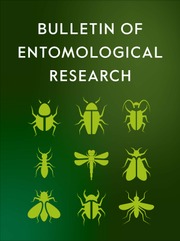Crossref Citations
This article has been cited by the following publications. This list is generated based on data provided by
Crossref.
Blackman, R. L.
1972.
The inheritance of life-cycle differences in Myzus persicae (Sulz.) (Hem., Aphididae).
Bulletin of Entomological Research,
Vol. 62,
Issue. 2,
p.
281.
LOWE, H. J. B.
1974.
Intraspecific variation of Myzus persicae on sugar beet (Beta vulgaris).
Annals of Applied Biology,
Vol. 78,
Issue. 1,
p.
15.
Blackman, R. L.
1974.
Life-cycle variation ofMyzus persicae(Sulz.) (Hom., Aphididae) in different parts of the world, in relation to genotype and environment.
Bulletin of Entomological Research,
Vol. 63,
Issue. 4,
p.
595.
BERANEK, A. P.
1974.
ESTERASE VARIATION AND ORGANOPHOSPHATE RESISTANCE IN POPULATIONS OF APHIS FABAE AND MYZUS PERSICAE.
Entomologia Experimentalis et Applicata,
Vol. 17,
Issue. 2,
p.
129.
Woodford, J. A. T.
and
Lerman, P. M.
1974.
Morphological variation in spring migrants ofMyzus persicae(Sulz.) (Hemiptera, Aphididae): comparison of alatae from peach and mangold.
Bulletin of Entomological Research,
Vol. 64,
Issue. 4,
p.
595.
Lees, A. D.
1975.
APHID POLYMORPHISM AND “DARWIN'S DEMON”.
Proceedings of the Royal Entomological Society of London, Series C. Journal of Meetings,
Vol. 39,
Issue. 11,
p.
59.
Blackman, R.L.
1975.
Photoperiodic determination of the male and female sexual morphs of Myzus persicae.
Journal of Insect Physiology,
Vol. 21,
Issue. 2,
p.
435.
BLACKMAN, R. L.
and
TAKADA, H.
1976.
A naturally occurring chromosomal translocation in Myzus persicae (Sulzer).
Journal of Entomology Series A, General Entomology,
Vol. 50,
Issue. 3,
p.
147.
Mittler, T.E.
Nassar, S.G.
and
Staal, G.B.
1976.
Wing development and parthenogenesis induced in progenies of kinoprene-treated gynoparae of Aphis fabae and Myzus persicae.
Journal of Insect Physiology,
Vol. 22,
Issue. 12,
p.
1717.
Richards, O. W.
and
Davies, R. G.
1977.
Imms’ General Textbook of Entomology.
p.
679.
Richards, O. W.
and
Davies, R. G.
1977.
Imms’ General Textbook of Entomology.
p.
679.
Blackman, Roger L.
and
Devonshire, Alan L.
1978.
Further studies on the genetics of the carboxylesterase regulatory system involved in resistance to organophosphorus insecticides in Myzus persicae (Sulzer).
Pesticide Science,
Vol. 9,
Issue. 6,
p.
517.
Sawicki, Roman M.
and
Rice, Adrian D.
1978.
Response of susceptible and resistant peach‐potato aphids Myzus persicae (Sulz.) to insecticides in leaf‐dip bioassays.
Pesticide Science,
Vol. 9,
Issue. 6,
p.
513.
BAKER, J. P.
1978.
Electrophoretic studies on populations of Myzjus persicae in Scotland from March to July, 1976.
Annals of Applied Biology,
Vol. 88,
Issue. 1,
p.
1.
Baker, John P.
1978.
Identification of the mutation responsible for an enzyme polymorphism.
Biochemical Genetics,
Vol. 16,
Issue. 11-12,
p.
1181.
Hoy, Marjorie A.
1978.
Evolution of Insect Migration and Diapause.
p.
101.
Sawicki, Roman M.
Devonshire, Alan L.
Rice, Adrian D.
Moores, Graham D.
Petzing, Stephanie M.
and
Cameron, Anne
1978.
The detection and distribution of organophosphorus and carbamate insecticide‐resistant Myzus persicae (Sulz.) in Britain in 1976.
Pesticide Science,
Vol. 9,
Issue. 3,
p.
189.
Whalon, M. E.
and
Smilowitz, Z.
1979.
The interaction of temperature and biotype on development of the green peach aphid,Myzus persicae (Sulz.).
American Potato Journal,
Vol. 56,
Issue. 12,
p.
591.
BLACKMAN, ROGER L.
1979.
Stability and variation in aphid clonal lineages.
Biological Journal of the Linnean Society,
Vol. 11,
Issue. 3,
p.
259.
Matsuka, M.
and
Mittler, T.E.
1979.
Production of males and gynoparae by apterous viviparae of Myzus persicae continuously exposed to different scotoperiods.
Journal of Insect Physiology,
Vol. 25,
Issue. 7,
p.
587.

